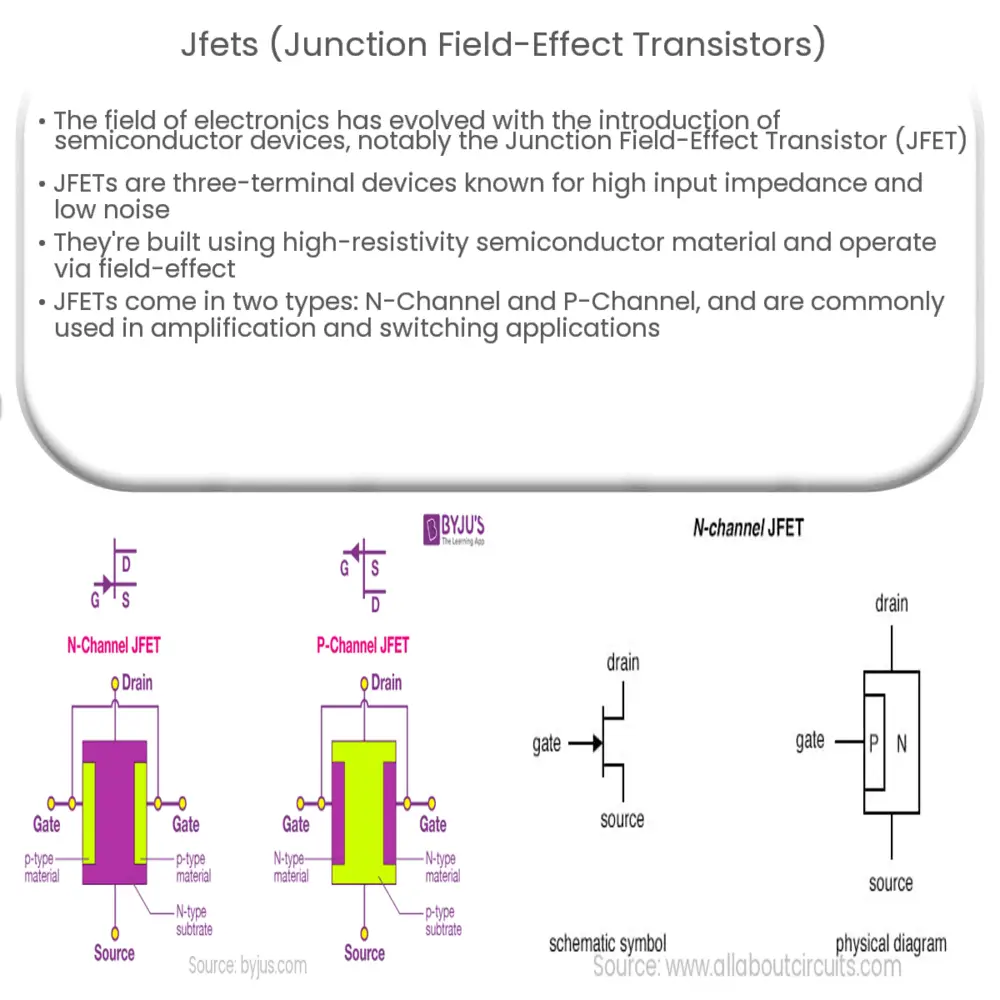Explore the world of Junction Field-Effect Transistors (JFETs), their structure, operation, types, applications, and key characteristics in this comprehensive guide.

Introduction to Junction Field-Effect Transistors (JFETs)
The field of electronics has witnessed a massive evolution with the advent of semiconductor devices. Among the devices contributing to this evolution, the Junction Field-Effect Transistor (JFET) holds a significant position. JFETs are three-terminal semiconductor devices, widely used in the world of electronics for their high input impedance and low noise characteristics.
Structure and Operation of JFETs
A JFET is built with a piece of high-resistivity semiconductor material (either n-type or p-type) that forms the main body or channel of the device. This channel is sandwiched between two p-type or n-type materials (depending upon whether it is an n-channel or p-channel JFET), forming a ‘p-n junction’ on both sides of the channel.
These p-n junctions are formed by the process of doping, in which impurity atoms are added to the semiconductor material. The three terminals of the device are the source (S), gate (G), and drain (D). The source and drain are connected to the ends of the channel, while the gate is connected to the p-n junction.
The operation of a JFET is majorly governed by the field-effect, which implies the control of current by an electric field. In a JFET, this electric field is applied through the gate terminal, hence controlling the current flow from the source to the drain. As the gate voltage is varied, it modulates the width of the channel, thereby controlling the current flow.
Types of JFETs
JFETs are broadly classified into two categories:
- N-Channel JFETs: In these devices, the channel is composed of n-type material, and the gate material is p-type. N-Channel JFETs are more commonly used due to their higher electron mobility, leading to better conductivity and speed.
- P-Channel JFETs: Contrary to n-channel devices, these JFETs have a p-type channel with n-type gate material. They possess lower conductivity compared to n-channel JFETs because of the lower mobility of holes (positive charge carriers) in the channel.
Applications of JFETs
JFETs find application in various domains due to their versatile characteristics. Some of the primary applications include:
- Amplification: Due to their high input impedance, JFETs are extensively used as amplifiers in electronic devices. They are particularly useful in low-noise, high-gain, and high-frequency applications.
- Switching: JFETs can be used as electronic switches. Their operation as a switch is based on the principle of controlling the channel’s conductivity via gate voltage.
Further Applications of JFETs
- Buffering: JFETs are often used as buffer amplifiers due to their high input impedance and low output impedance. This makes them useful in isolating stages of an electronic circuit from each other.
- Voltage Variable Resistors: In some applications, a JFET operates in the ohmic region (also known as the triode region) where it behaves as a voltage-controlled resistor. This characteristic is useful in analog circuits.
- Analog Circuits: The JFET’s unique characteristics make it ideal for use in various analog circuits, including operational amplifiers, oscillators, and filters.
JFET Characteristics and Parameters
Understanding the key characteristics and parameters of JFETs is crucial to their effective use. These include:
- Transconductance (gm): This is the ratio of the change in output current to the change in input voltage. It’s a measure of the JFET’s gain.
- Input Impedance: JFETs have a high input impedance due to the reverse-biased gate-channel junction. This makes them ideal for amplification applications.
- Cut-off Voltage (VGS(off)): This is the gate-source voltage at which the JFET channel is fully depleted, and the drain current becomes zero.
- Drain Resistance (rd): This is the resistance offered by the drain terminal to the flow of current.
Conclusion
In conclusion, the Junction Field-Effect Transistor (JFET) is an indispensable component in the field of electronics due to its unique characteristics and versatile applications. Its ability to control current flow using an electric field, high input impedance, and low noise properties make it ideal for a range of uses, from amplification to switching to buffering. As technology continues to advance, the role of JFETs in shaping electronic applications is expected to remain significant.

